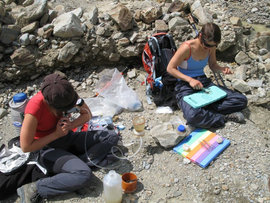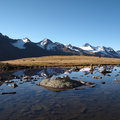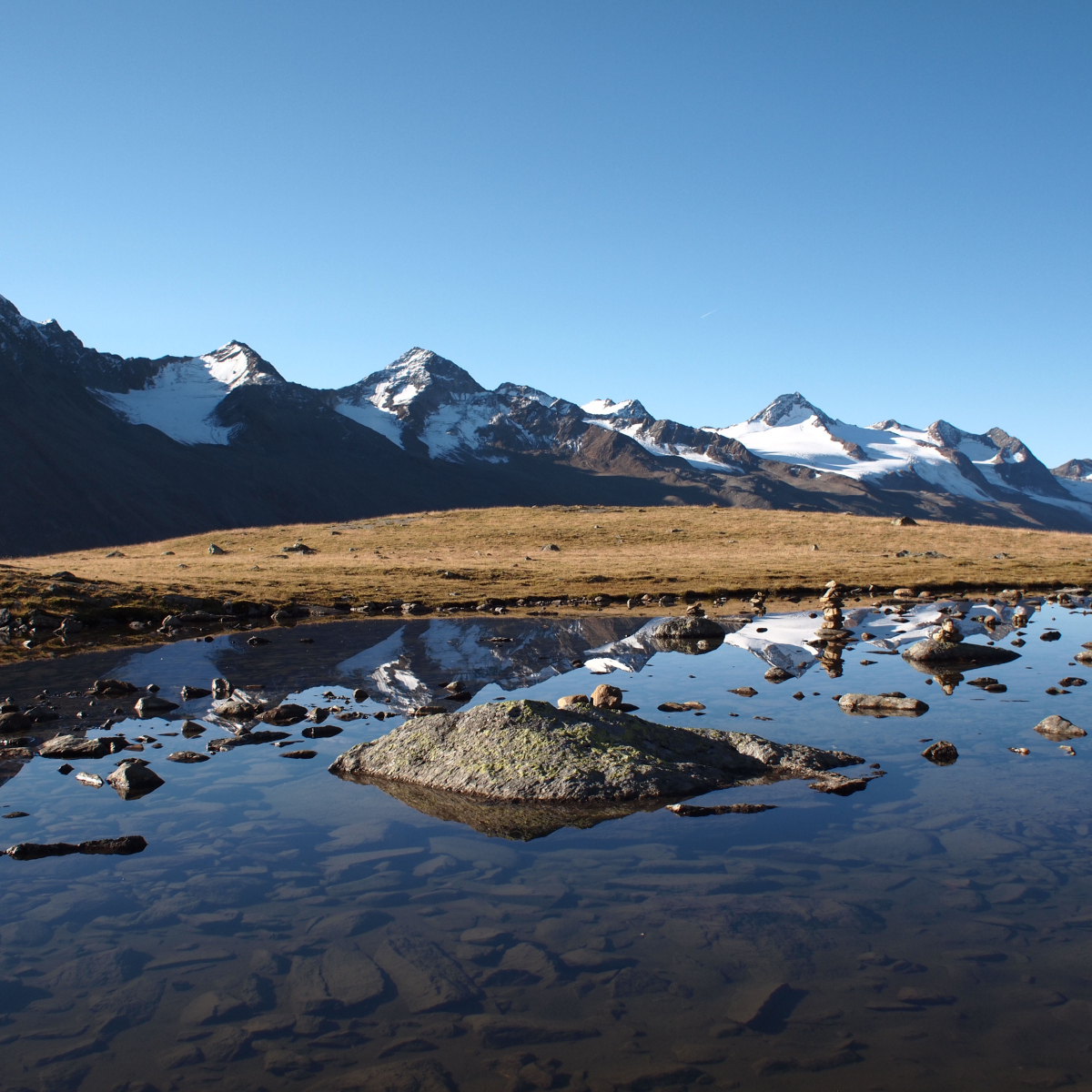Page path:
- Press Office
- Press releases 2012
- 17.09.2012 Alpine glaciers contribute to global...
17.09.2012 Alpine glaciers contribute to global carbon cycling
An international collaboration by Tom Battin and his group from the University of Vienna and scientists from the Max Planck Institute for Marine Microbiology unravels the role of Alpine glaciers for carbon cycling. The scientists uncover the unexpected biogeochemical complexity of dissolved organic matter locked in glaciers and study its fate for carbon cycling in glacier-fed streams. Their paper, now published in Nature Geoscience, expands current knowledge on the importance of the vanishing cryosphere for biogeochemistry.
Glacier in Vent, Austia (Copyright: Tom J. Battin)
Glaciers are receding worldwide with noticeable implications for the hydrological cycle, including sea-level rise. The potential role of glaciers in the carbon cycle remains poorly understood. An international research team led by Tom J. Battin, Department of Limnology, at the University of Vienna has been able to unravel the biogeochemical complexity of dissolved organic matter in 26 glaciers in the Austrian Alps. The study focused on dissolved organic compounds that are present in the melt water after melting of the glacier ice.
Gabriel A. Singer, in collaboration with Thorsten Dittmar and Jutta Niggemann of the Max Planck Institue for Marine Microbiology examined,and identified thousands of organic compounds locked in the glacial ice by ultra-high resolution mass spectrometry. “Our mass spectrometer enables us to identify single molecules in a mixed sample with high precision”, says Thorsten Dittmar. Together with his group he works at the University of Oldenburg branch of the The Max Planck Institute. For several years now they investigate the global carbon cycle and the dissolved organic matter in the oceans .
Christina Fasching, together with Peter Steier, Faculty of Physics, Vienna Environmental Research Accelerator, estimated the radiocarbon age of the ice-locked organic carbon at several thousand years. She also determined the bioavailability of ice-locked organic carbon for microbial heterotrophs in the glacier-fed streams. For the first time, the researchers were able to relate, at the compound-specific level, radiocarbon age and carbon bioavailability to distinct molecular groups.
Gabriel A. Singer, in collaboration with Thorsten Dittmar and Jutta Niggemann of the Max Planck Institue for Marine Microbiology examined,and identified thousands of organic compounds locked in the glacial ice by ultra-high resolution mass spectrometry. “Our mass spectrometer enables us to identify single molecules in a mixed sample with high precision”, says Thorsten Dittmar. Together with his group he works at the University of Oldenburg branch of the The Max Planck Institute. For several years now they investigate the global carbon cycle and the dissolved organic matter in the oceans .
Christina Fasching, together with Peter Steier, Faculty of Physics, Vienna Environmental Research Accelerator, estimated the radiocarbon age of the ice-locked organic carbon at several thousand years. She also determined the bioavailability of ice-locked organic carbon for microbial heterotrophs in the glacier-fed streams. For the first time, the researchers were able to relate, at the compound-specific level, radiocarbon age and carbon bioavailability to distinct molecular groups.

Field laboratory at a glacier-fed stream (Copyright: Christian Preiler)
The researchers found that the biogeochemistry of the glacier organic matter is unexpectedly diverse. Phenolic compounds derived from vascular plants or soil dominate, together with peptides and lipids, potentially derived from microorganisms dwelling in glacial ice. Combustion products from fossil fuel, in contrast, seem to contribute only marginally to glacial organic matter. A significant fraction of this plant-derived compounds - although several thousand years old - is bioavailable. This finding runs counter to logical perceptions of known relationships between age and bioavailability of organic matter, and highlights glaciers as "freezers" that preserve organic matter as resource to microbial heterotrophs.
Upon release, glacial organic matter may stimulate the heterotrophic metabolism in glacier-fed streams otherwise often devoid of energy sources. Thus, microorganisms in glacier-fed streams may respire ancient organic carbon that ultimately leaves the streams as carbon dioxide to the atmosphere. Dissolved organic compounds from the glacier ice that cannot be degraded in the glacier streams can reach larger rivers and eventually the oceans and hence influence the global carbon cycle.These findings therefore shed new light on the role of mountain glaciers and alpine streams in the global carbon cycle.
The research, funded by the START program of the Austrian Science Foundation (FWF), adds yet another piece to our knowledge on the contribution of freshwater to carbon cycling. The research was undertaken as collaboration between the Faculty of Life Sciences and the Faculty of Physics at the University of Vienna, the Max Planck Institute of Marine Microbiology at Bremen, the University of Oldenburg and the WasserCluster Lunz GmbH.
Original article:
Biogeochemically diverse organic matter in Alpine glaciers and its downstream fate: Singer, G.A, C. Fasching, L.Wilhelm, J. Niggemann, P. Steier, T. Dittmar & T.J. Battin. Nature Geoscience (2012). DOI: 10.1038/NGEO1581
For further information please contact:
Tom J. Battin
Department of Limnology
University of Vienna
1090 Vienna, Althanstraße 14
Phone +43-1-4277-572 00
[Bitte aktivieren Sie Javascript]
Dr. Thorsten Dittmar
Max-Planck-Institut for Marine Microbiology
Research Group Marine Geochemistry
Carl von Ossietzky University
Carl-von-Ossietzky-Straße 9-11
D-26129 Oldenburg
Phone: +49 (0)441 798 - 3602
Fax: +49 (0)441 798 - 3358
[Bitte aktivieren Sie Javascript]
Upon release, glacial organic matter may stimulate the heterotrophic metabolism in glacier-fed streams otherwise often devoid of energy sources. Thus, microorganisms in glacier-fed streams may respire ancient organic carbon that ultimately leaves the streams as carbon dioxide to the atmosphere. Dissolved organic compounds from the glacier ice that cannot be degraded in the glacier streams can reach larger rivers and eventually the oceans and hence influence the global carbon cycle.These findings therefore shed new light on the role of mountain glaciers and alpine streams in the global carbon cycle.
The research, funded by the START program of the Austrian Science Foundation (FWF), adds yet another piece to our knowledge on the contribution of freshwater to carbon cycling. The research was undertaken as collaboration between the Faculty of Life Sciences and the Faculty of Physics at the University of Vienna, the Max Planck Institute of Marine Microbiology at Bremen, the University of Oldenburg and the WasserCluster Lunz GmbH.
Original article:
Biogeochemically diverse organic matter in Alpine glaciers and its downstream fate: Singer, G.A, C. Fasching, L.Wilhelm, J. Niggemann, P. Steier, T. Dittmar & T.J. Battin. Nature Geoscience (2012). DOI: 10.1038/NGEO1581
For further information please contact:
Tom J. Battin
Department of Limnology
University of Vienna
1090 Vienna, Althanstraße 14
Phone +43-1-4277-572 00
[Bitte aktivieren Sie Javascript]
Dr. Thorsten Dittmar
Max-Planck-Institut for Marine Microbiology
Research Group Marine Geochemistry
Carl von Ossietzky University
Carl-von-Ossietzky-Straße 9-11
D-26129 Oldenburg
Phone: +49 (0)441 798 - 3602
Fax: +49 (0)441 798 - 3358
[Bitte aktivieren Sie Javascript]

